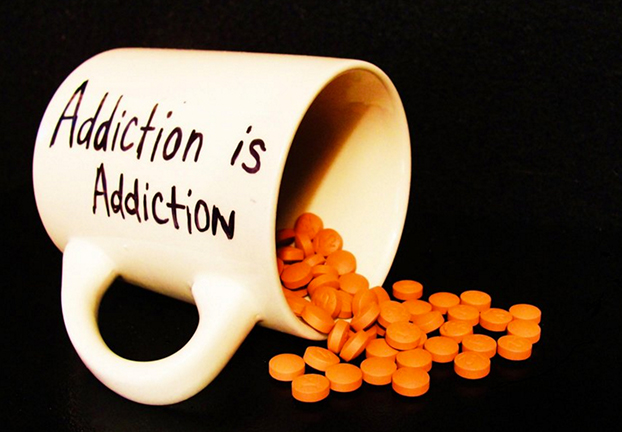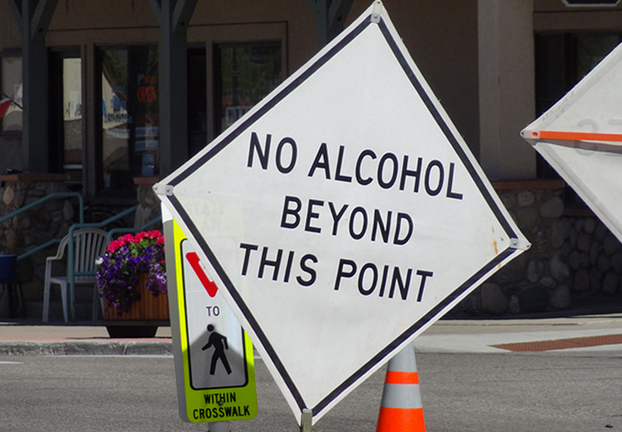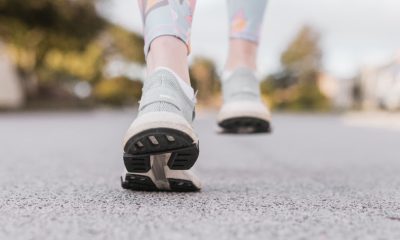Fitness
Are you an addict? Find out the truth here
The bad news is that on some level, all addictions are bad for you. You might think that binging Netflix all day is not particularly bad for you. Scientists claim sitting down is just as dangerous as smoking cigarettes every day. So, unless you’re watching Orange Is The New Black while working out, you are putting your health in danger. Of course, we don’t have rehabilitation facilities for TV bingers, but we do for alcoholics and drug users. Why is this?

We often associate an addiction as being related to certain substances. You might be addicted to an illegal drug, or perhaps a legal drug like alcohol. You may also be addicted to a harmful activity such as gambling that some people believe is just as addictive as cocaine.
There is evidence to suggest that casino owners make gambling more addictive by tampering with the environment. Or, even controlling the odds. If you win the first round, you’re more likely to play big in the second and then inevitably lose it all in the third. In fact, there’s a fact about gambling that everyone should know. The big winners often lose what they make on the same night because they are “persuaded” not to leave the casino. In Vegas, you are lucky if you even break even. So, yes, gambling is a dangerous addiction.
IMAGE SOURCE: PIXABAY
However, it’s important to realize that addictions do not have to be dangerous. The official definition of addiction is a condition being addicted to a certain substance or activity. There is no mention of that substance or activity being harmful.
Of course, it could be argued that anything in excess is harmful. An example of this might be running. If you run on a regular basis, this can be good for your body. It will keep your body healthy and keep your body fat levels quite low. However, if you run every day for more than two hours, you might be doing more harm than good. You can damage the joints in your legs, making it more likely that you develop arthritis as you age.
Thus, it does seem being addicted to a health activity can ultimately, damage your health. That’s a brutal irony of healthy living.
TYPES OF ADDICTION
IMAGE SOURCE: DEVIANT ART
The truth is that we are all addicted to something. If you don’t think you’re an addict, consider the activity that you love completing the most. Or, the substance that you love taking the most. That might be watching TV, drinking, eating chocolate or weight lifting. Now, consider how often you complete these activities or consume these substances. After that, consider how difficult it would be to stop these activities or to stop taking these substances if you had to. If the answers were “all the time” and “incredibly difficult,” you probably do have an addiction. If you still don’t think you have an addiction, there’s a good chance you’re lying to yourself.
The bad news is that on some level, all addictions are bad for you. You might think that binging Netflix all day is not particularly bad for you. Scientists claim sitting down is just as dangerous as smoking cigarettes every day. So, unless you’re watching Orange Is The New Black while working out, you are putting your health in danger. Of course, we don’t have rehabilitation facilities for TV bingers, but we do for alcoholics and drug users. Why is this?
Firstly, the dangers of drug and alcohol addiction have been known and reported on for some time. Both have harmful effects on the body and the mind. For other addictions, research isn’t quite as clear. As well as this, other addictions aren’t as common. Therefore, while there are dangers from being addicted to other things it’s these big two that you need to worry about. Finally, other addictions are far more socially acceptable. Take caffeine as an example here. A caffeine addiction can be quite dangerous, but it is not taken as seriously as alcohol. That’s why we’re going to be focusing on the big two when finding out whether you have an addiction.
SIGNS YOU ARE ADDICTED TO ALCOHOL OR DRUGS
IMAGE SOURCE: PIXABAY
Let’s look at alcohol first and think what it means to be addicted to this dangerous substance. When assessing whether you have an addiction, most doctors will ask how you drink alcohol. For instance, they may enquire as to whether you are purely a social drinker. By this, they mean that you never drink by yourself or privately.
They may also ask you about how much you drink each week. Most physicians will agree that if you have one glass of wine each night, this does not necessarily make you an alcoholic. It also depends on how much you need that glass of wine or dose of alcohol. To elaborate on this, we can think about mouthwash. Some mouthwash contain small levels of alcohol. Alcoholics can use this small dose to get the fix that they crave. Therefore you could be an addict and not buy any alcoholic drinks at all.
Most people who drink will not consider themselves an alcoholic. Truth be told, they probably aren’t. The development of an addiction depends on a number of different factors. Genetics may have an impact on addiction levels. If your parent is an alcoholic, there’s a possibility that you might have this addiction as well. Similarly, you may have the genes that mean you are not easily addicted to otherwise addictive substances. This is why some people can take or leave cigarettes while others face severe levels of craving.
However, when considering whether you have an addiction to alcohol, you need to decide whether you can survive without it. If you can easily go one week without any alcohol, you are not addicted.
For drugs, the situation is a little different. This is because there are illegal and legal narcotics. For instance, paracetamol can be bought over the counter. However, if you take too many, you can get addicted to the drug. On the opposite side of the scale, there is marijuana. An illegal drug with very little evidence of addictive traits at all. As such, there are two ways to know whether you are addicted to drugs.
If you are using a legal drug but taking more than recommended, you may have an addiction. Using an illegal drug is always dangerous, but it is not necessarily addictive. It is only addictive if you constantly, find that you need a fix for your craving.
THE NEXT STEP
IMAGE SOURCE: FLICKR
If you have reached this point in the article, you may have realized that you do have an addiction. The question then becomes, what should you do about it? Already, you might have decided that there is no reason to take any official action at all.
This is usually where the idea of a functioning alcoholic or a functioning addict begins to form. Rather than admit you have a problem, you continue on the path that you have already chosen. There are people who believe themselves to be functioning alcoholics. Essentially, this means that they can get through life without their addiction posing a major issue. They do not resort to dangerous and damaging behaviour such as stealing to provide for their addiction.
However, there is a problem with this train of thought. Usually, functioning alcoholics progress into full blown addicts. At that point, they lose their way completely and start to travel down a dangerous road. The addiction takes over their life, destroying relationships and even their career.
You don’t have to let it get to this point. The hardest part is over, and that is admitting that you have a problem. But with drugs and alcohol admitting you are an addict isn’t the end of the fight. Typically, people need trained professionals to help them beat the addiction. This might involve treatment that includes both drugs and therapy. For instance, you can discover Alcohol Recovery Centre online. There you will find all the advice you need on beating addition and getting clean.
Of course, medical treatment can only go so far. If you want to get better, you will also need the support of your friends and your family. You need to admit to them that you have a problem so that they can help you through it in any way possible. Let them be your support as you climb this mountain and find a better, healthier life, on the other side.
One of the biggest mistakes that you can make as an addict is thinking that you need to travel this path alone. You don’t, and if you do this, you might be putting yourself in more danger. When there’s no one with you, helping you, it’s easy to fall back into old habits for support. Don’t make this mistake and instead allow those around you to provide the support you need.
A LIFE WITHOUT ADDICTION
IMAGE SOURCE: Pixabay
Once you beat your addiction, you will notice how much your life has changed. When you are under the constraints of a harmful addiction, it can be like walking around in a thick fog. You know things aren’t right, but you can’t see them clearly. After you get past your addiction, that fog will lift, and you will see the world as it is. This can be both a positive and negative experience. You will have to find other ways to deal with problems that you have had in your life. But, with a new perspective, you will be ready for these challenges and a new chapter of your world will begin.
Fitness
Treatment options to help overcome knee pain for sports enthusiasts
“Sports-related pain should be evaluated quickly, especially when it’s difficult to put weight on the knee, swelling occurs or there is restricted range of motion,” said Dr. Alexander Meininger, orthopedic surgeon and MACI consultant.

Millions of people experience chronic pain, with knee pain among the most common. Athletes and active adults know the impact activities like running and skiing can have on their knees, but when chronic knee pain makes it difficult to do those activities, or even day-to-day tasks like walking up the stairs, people may often face challenges.
According to the journal “Cartilage,” unlike other tissues, cartilage does not repair itself and, without proper treatment, can worsen over time and become more difficult to treat. However, options like FDA-approved knee cartilage repair surgery MACI (autologous cultured chondrocytes on porcine collagen membrane) uses a patient’s cells to help repair cartilage defects and may help alleviate knee pain.
“Sports-related pain should be evaluated quickly, especially when it’s difficult to put weight on the knee, swelling occurs or there is restricted range of motion,” said Dr. Alexander Meininger, orthopedic surgeon and MACI consultant.
Justin Keys, a former patient of Meininger and avid skier, knows that the long-term outcomes of knee cartilage surgery can be worth the short-term sacrifices. After several injuries, including an ACL injury, Keys struggled with most activities except walking on flat, paved surfaces. After consulting with Meininger, Keys chose knee cartilage repair to help get back to his active lifestyle.
Keys considered whether to manage the injury as-is or choose MACI and undergo rehabilitation to potentially get back to his favorite activities in the future. He knew he could no longer use short-term relief methods and had to address his pain with a treatment to help provide lasting relief.
For athletes like Keys who want to fix knee pain, it’s important to consider these steps:
Discuss Options with Your Doctor
Patients should talk to their doctors and undergo an MRI to help assess the internal structures of the knee. Meininger recommends patients and their doctors discuss options for long-term knee restoration health, preserving function for future decades and recognizing the short-term sacrifice.
Set Yourself Up for Success
Experts like Meininger suggest patients take steps ahead of surgery to help their recovery.
“The important thing is to be as fit as possible and use the preseason months to undergo surgery and rehab,” Meininger said.
Patients can take steps to prep their home for recovery, which may include:
- Bringing necessities down from hard-to-reach shelves
- Moving furniture to ensure clear pathways
- Installing shower safety handles to minimize potential falls
The Road to Rehab and Recovery
Rehabilitation takes time and everyone’s experience is unique. It can be as much of a mental challenge as it is physical. Committing to a physical therapy regime, staying hydrated and eating well are important aspects to support recovery. Patients should talk to their doctors with questions and before starting any exercises.
IMPORTANT SAFETY INFORMATION
Do not use if you are allergic to antibiotics such as gentamicin or materials from cow or pig; have severe osteoarthritis of the knee, other severe inflammatory conditions, infections or inflammation in the bone joint and other surrounding tissue or blood clotting conditions; had knee surgery in the past 6 months, not including surgery for obtaining a cartilage biopsy or a surgical procedure to prepare your knee for a MACI implant; or cannot follow a rehabilitation program post-surgery.
Fitness
6 Exercise safety tips
Now, as social restrictions ease, you may find yourself stepping up your workouts, whether you’re training for an event or working to improve your game in a recreational league.

In the wake of the COVID-19 pandemic, many Americans are more aware of their health and wellness. Now, as social restrictions ease, you may find yourself stepping up your workouts, whether you’re training for an event or working to improve your game in a recreational league.
Sprains, strains and injuries can happen to even the most seasoned athletes. When you’re testing your limits, even a minor injury can alter your performance. Consider products and supports like these from the CURAD Performance Series product line, available at Walmart and Amazon, to help you get back in the game quickly and safely.
Find more resources to support your fitness journey at CURAD.com.
Keep Dirt and Germs Away
The more active you are, the harder it can be to find a bandage that stays with you all day or all game long.
Spray Away Sore Spots
Controlling mild pain can help keep you at the top of your game, and a topical analgesic works fast to heal common pain brought on by fitness and exercise, such as pain in knees, feet, shoulders and backs.
Put Pain in the Past
When recovery becomes the name of the game and pain relief is needed after daily workouts or bodily injuries. Cold packs work to heal bruises, reduce swelling and relieve headaches and general pain points while microwavable heat packs provide satisfying heat therapy to address sore and stiff joints, muscle cramps and tension.
Reduce Impact of Knee Strain
Weak, injured or arthritic knees can come from many sources, including tendonitis and a wide range of conditions that result in strain or overuse. An adjustable band can provide support for on-field sports and during workouts or everyday activities.
Manage Pain and Relieve Pressure
If you participate in endurance and strength exercises or certain sports, you may ask a lot of your joints. Kinesiology tape can be configured a multitude of ways to help reduce pain and improve blood circulation, as well as relieve tension and pressure.
Control Back Strain
When your back is strained, your body and performance can suffer. A mild or moderate sprain can benefit from strong support and compression.
Fitness
Exercise can provide relief for dry, itchy eyes
A significant increase in tear secretion and tear film stability after participating in aerobic exercise can be another remedy for relieving dry, itchy eyes.

A team led by researchers from the University of Waterloo discovered that a significant increase in tear secretion and tear film stability after participating in aerobic exercise can be another remedy for relieving dry, itchy eyes.
Every time we blink, our eyes are covered in tear film—an essential protective coating necessary for maintaining healthy ocular function. Healthy tear film comprises three layers–oil, water, and mucin–that work together to hydrate the ocular surface and protect against infection-causing irritants like dust or dirt.
When any part of the tear film becomes unstable, the ocular surface can develop dry spots, causing eye symptoms like itchiness or stinging and burning sensations.
“With so much of our activity tied to screen usage, dry eye symptoms are becoming increasingly common,” said Heinz Otchere, a PhD candidate in vision science at Waterloo. “Instead of having to use eye drops or other alternative treatments, our study aimed to determine if remaining physically active can be an effective preventative measure against dryness.”
Fifty-two participants were divided into two groups—athlete and non-athlete—to participate in an exercise session. Participants in the athlete group exercised at least five times per week, while non-athlete participants exercised no more than once per week. Researchers, which included experts from the University of Cape Coast in Ghana, performed visual examinations before and five minutes after each exercise session, where tear secretion and tear break-up time were assessed.
While participants in the athlete group showed the largest increase, Otchere says all participants experienced a meaningful boost in tear quantity and tear film stability after the exercise session.
“It can be challenging for people to regularly exercise when the demand is there to work increasingly longer hours in front of screens,” Otchere said. “However, our findings show physical activity can be really important for not just our overall well-being, but for our ocular health too.”
The study, Differential effect of maximal incremental treadmill exercise on tear secretion and tear film stability in athletes and non-athletes, was co-authored by Otchere, the University of Cape Coast’s Samuel Abokyi, Sekyere Nyamaah, and Michael Ntodie, and Ghana’s Our Lady of Grace Hospital’s Yaw Osei Akoto. It was recently published in the Experimental Eye Research journal.
-

 Product Showcase3 weeks ago
Product Showcase3 weeks agoJetstar announces direct flights to Australia from Manila and Cebu
-

 Product Showcase2 weeks ago
Product Showcase2 weeks agoPalawan Group of Companies Introduces ProtekTODO
-

 Destinations4 weeks ago
Destinations4 weeks agoRevisiting the no-entry-allowed Malabrigo Point Lighthouse
-

 Nutrition3 weeks ago
Nutrition3 weeks agoFall for flavor: The new Maple Cloud Cream Collection is here to sweeten, only at Seattle’s Best Coffee
-

 Product Showcase2 weeks ago
Product Showcase2 weeks agoWhy Mega Sardines is a smart, healthy choice for every Filipino family
-

 Pet Care4 weeks ago
Pet Care4 weeks agoWorld-class pet travel safety arrives in PH with Tavo
-

 NewsMakers3 weeks ago
NewsMakers3 weeks agoIs your health care provider really listening to you?
-

 Beauty & Fashion2 weeks ago
Beauty & Fashion2 weeks agoRenting clothes for sustainable fashion – niche markets work best






















